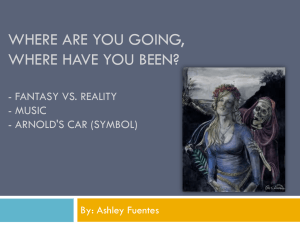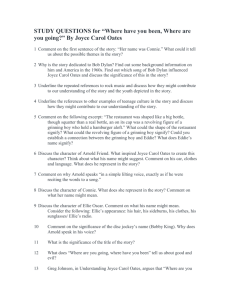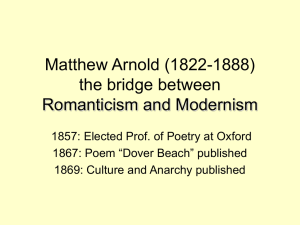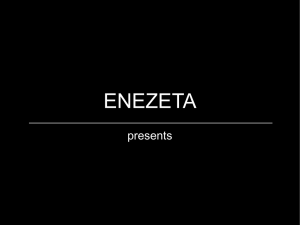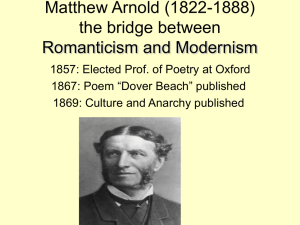Quotations Log (Messiah Figure)
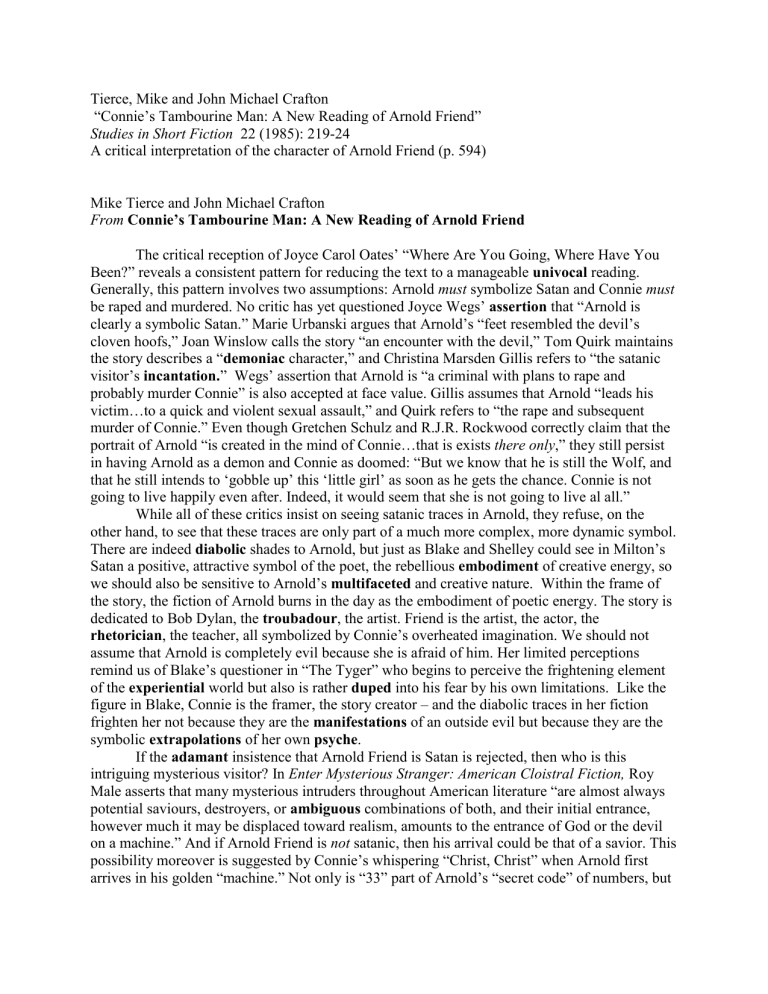
Tierce, Mike and John Michael Crafton
“Connie’s Tambourine Man: A New Reading of Arnold Friend”
Studies in Short Fiction 22 (1985): 219-24
A critical interpretation of the character of Arnold Friend (p. 594)
Mike Tierce and John Michael Crafton
From Connie’s Tambourine Man: A New Reading of Arnold Friend
The critical reception of Joyce Carol Oates’ “Where Are You Going, Where Have You
Been?” reveals a consistent pattern for reducing the text to a manageable univocal reading.
Generally, this pattern involves two assumptions: Arnold must symbolize Satan and Connie must be raped and murdered. No critic has yet questioned Joyce Wegs’ assertion that “Arnold is clearly a symbolic Satan.” Marie Urbanski argues that Arnold’s “feet resembled the devil’s cloven hoofs,” Joan Winslow calls the story “an encounter with the devil,” Tom Quirk maintains the story describes a “ demoniac character,” and Christina Marsden Gillis refers to “the satanic visitor’s incantation.
” Wegs’ assertion that Arnold is “a criminal with plans to rape and probably murder Connie” is also accepted at face value. Gillis assumes that Arnold “leads his victim…to a quick and violent sexual assault,” and Quirk refers to “the rape and subsequent murder of Connie.” Even though Gretchen Schulz and R.J.R. Rockwood correctly claim that the portrait of Arnold “is created in the mind of Connie…that is exists there only
,” they still persist in having Arnold as a demon and Connie as doomed: “But we know that he is still the Wolf, and that he still intends to ‘gobble up’ this ‘little girl’ as soon as he gets the chance. Connie is not going to live happily even after. Indeed, it would seem that she is not going to live al all.”
While all of these critics insist on seeing satanic traces in Arnold, they refuse, on the other hand, to see that these traces are only part of a much more complex, more dynamic symbol.
There are indeed diabolic shades to Arnold, but just as Blake and Shelley could see in Milton’s
Satan a positive, attractive symbol of the poet, the rebellious embodiment of creative energy, so we should also be sensitive to Arnold’s multifaceted and creative nature. Within the frame of the story, the fiction of Arnold burns in the day as the embodiment of poetic energy. The story is dedicated to Bob Dylan, the troubadour , the artist. Friend is the artist, the actor, the rhetorician
, the teacher, all symbolized by Connie’s overheated imagination. We should not assume that Arnold is completely evil because she is afraid of him. Her limited perceptions remind us of Blake’s questioner in “The Tyger” who begins to perceive the frightening element of the experiential world but also is rather duped into his fear by his own limitations. Like the figure in Blake, Connie is the framer, the story creator – and the diabolic traces in her fiction frighten her not because they are the manifestations of an outside evil but because they are the symbolic extrapolations of her own psyche .
If the adamant insistence that Arnold Friend is Satan is rejected, then who is this intriguing mysterious visitor? In Enter Mysterious Stranger: American Cloistral Fiction, Roy
Male asserts that many mysterious intruders throughout American literature “are almost always potential saviours, destroyers, or ambiguous combinations of both, and their initial entrance, however much it may be displaced toward realism, amounts to the entrance of God or the devil on a machine.” And if Arnold Friend is not satanic, then his arrival could be that of a savior. This possibility moreover is suggested by Connie’s whispering “Christ, Christ” when Arnold first arrives in his golden “machine.” Not only is “33” part of Arnold’s “secret code” of numbers, but
his sign, and “X” that seems to hover in the air, is also one of those symbols for Christ. Because music is closely associated with religion – “the music was always in the background, like music at a church service” – it also adds a religious element to Arnold’s arrival. The key question then is who is this musical messiah , and the key to the answer is the dedication “For Bob Dylan” – the element of the story so unsatisfactorily accounted for by our predecessors . Not only does the description of Arnold Friend also fit Bob Dylan – a type of rock and roll messiah – but three of
Dylan’s songs (popular when the story was written) are very similar to the story itself.
In the mid-sixties Bob Dylan’s followers perceived him to be a messiah. According to his biographer, Dylan was a “rock and roll king.” It is no wonder then that Arnold speaks with “the voice of the man on the radio,” the disc jockey whose name, Bobby King, is a reference to
“Bobby” Dylan, the “king” of rock and roll. Dylan was more than just a “friend” to his listeners, he was “Christ revisited,” “the prophet leading his followers into a new Consciousness.” In fact,
“people were making him an idol;…thousands of men and women, young and old, felt their lives entwined with his because they saw him as a mystic , a messiah who would lead them to salvation.”
That Oates consciously associates Arnold Friend is clearly suggested by the similarities of their physical descriptions. Arnold’s “shaggy, shabby black hair that looked crazy as a wig,” his “long and hawk-like” nose, his unshaven face, his “big and white” teeth, his lashes, “thick and black as if painted with a black tarlike material” and his size (“only an inch or so taller than
Connie”) are all characteristic of Bob Dylan. Even Arnold’s “fast, bright, monotone voice” is suggestive of Dylan, especially since he speaks “in a simple lilting voice, exactly as if he were reciting the words to a song.”
The reference to “Mr. Tambourine Man” implies another connection between the story and Dylan. A few of his song lyrics are very similar to the story itself. Oates herself suggests that part of the story’s inspiration was “hearing for some weeks Dylan’s song “It’s All Over Now,
Baby Blue.” Such lines as “you must leave now,” “something calls for you,” “the vagabond who’s rapping at your door,” and “go start anew” are suggestive of the impending change awaiting Connie. Two other Dylan songs are equally as applicable though. The following lines from “Like a Rolling Stone” – the second most popular song of 1965 (the story was first published in 1966) – are also very similar to Connie’s situation at the end of the story:
You used to be so amused
At Napoleon in rags and the language that he used
Go to him now, he calls you, you can’t refuse
When you got nothing, you go nothing to lose
You’re invisible now, you got no secrets to conceal.
But Dylan’s “Mr. Tambourine Man” – the number ten song in 1965 – is even more similar. The following stanza establishes the notion of using music to rouse one’s imagination into a blissful fantasy world:
Take me on a trip upon your magic swirlin’ ship
My senses have been stripped
My hands can’t feel to grip,
My toes too numb to step,
Wait only for my boot heels to be wanderin’.
I’m ready to go anywhere,
I’m ready for to fade
Into my own parade.
Cast your dancin’ spell my way,
I promise to go under it.
Hey, Mister Tambourine Man, play a song for me,
I’m not sleepy and there ain’t no place I’m going to.
Hey, Mr. Tambourine Man, play a song for me.
In the jingle, jangle morning I’ll come followin’ you.
Arnold Friend’s car – complete with the phrase “MAN THE FLYING SAUCERS” – is just such a “magic swirlin’ ship.” Arnold is the personification of popular music, particularly Bob
Dylan’s music; and as such, Connie’s interaction with him is musically induced fantasy, a kind of “magic carpet ride” in “a convertible jalopy painted gold.” Rising our of Connie’s radio,
Arnold Friend/Bob Dylan is a magical, musical messiah; he persuades Connie to abandon her father’s house. As a manifestation of her own desires, he frees her from the limitations of a fifteen-year-old girl, assisting her maturation by stripping her of her childlike vision.
